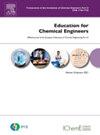化学工程教育中的因果关系:机器学习在故障诊断中的应用
IF 2.3
2区 教育学
Q1 EDUCATION, SCIENTIFIC DISCIPLINES
引用次数: 0
摘要
本研究整合了一个练习的设计和预评估,将因果关系建模方法纳入田纳西伊士曼过程(TEP)数据集,以增强工程专业学生对过程监控和故障诊断的理解。该数据集包含41个正常和故障条件下的测量变量和11个操纵变量,用于说明机器学习算法因果随机森林(CRF)和处理效果估计在化学过程分析中的应用。这种方法不同于传统的通过控制方程、启发式和实验室实验来教授/学习复杂化学工程现象的方法。本练习开发了三个学习成果:理解数据集组成对模型解释的影响,理解模型性能指标在应用于回归和分类任务时的差异,以及理解使用不同处理变量的因果关系。这些学习成果旨在为学生提供数据完整性、模型评估和因果推理方面的坚实基础。在工程教育的背景下,我们对将此练习应用于课程队列的有效性的预评估是由一名暑期学生在导师的密切监督下进行的。虽然3小时的课程被证明是有价值的,并且在某种程度上是可行的,但从这个预评估中收集了一些逻辑挑战,主要是关于时间限制和数据集的复杂性,这表明将练习分成更小的课程并提供额外的资源将增强学生的理解,以及为学生提供更清晰的技术概念解释,以及互动反馈以增加未来实施的参与度。本文章由计算机程序翻译,如有差异,请以英文原文为准。
Causation in chemical engineering education: Application of machine learning in fault diagnosis
This study integrates the design and preassessment of an exercise, incorporating a causation modeling approach into the Tennessee Eastman Process (TEP) dataset to enhance engineering students' understanding of process monitoring and fault diagnosis. The dataset, which contains 41 measured and 11 manipulated variables under normal and faulty conditions, was used to illustrate the application of the machine learning algorithm causal random forests (CRF) and treatment effect estimation in chemical process analysis. This approach differs from traditional ways of teaching/learning complex chemical engineering phenomena through governing equations, heuristics, and lab experiments. Three learning outcomes were developed for this exercise: understanding the impact of dataset composition on model interpretation, understanding how the model performance metrics differ when applied to regression and classification tasks, and understanding causality using different treatment variables. These learning outcomes were proposed to provide students with strong foundations in data integrity, model evaluation, and causal inference. In the context of engineering education, our preassessment of the effectiveness of applying this exercise to a course cohort was conducted by a summer student and closely supervised by the instructor. While the 3-hour session proved valuable and somehow feasible, some logistic challenges were gathered from this preassessment, mainly regarding time constraints and the complexity of the dataset, suggesting that breaking the exercise into smaller sessions and offering additional resources would enhance student understanding, as well as providing students with clearer explanations of technical concepts, and interactive feedback to increase engagement in future implementations.
求助全文
通过发布文献求助,成功后即可免费获取论文全文。
去求助
来源期刊

Education for Chemical Engineers
Multiple-
CiteScore
8.80
自引率
17.90%
发文量
30
审稿时长
31 days
期刊介绍:
Education for Chemical Engineers was launched in 2006 with a remit to publisheducation research papers, resource reviews and teaching and learning notes. ECE is targeted at chemical engineering academics and educators, discussing the ongoingchanges and development in chemical engineering education. This international title publishes papers from around the world, creating a global network of chemical engineering academics. Papers demonstrating how educational research results can be applied to chemical engineering education are particularly welcome, as are the accounts of research work that brings new perspectives to established principles, highlighting unsolved problems or indicating direction for future research relevant to chemical engineering education. Core topic areas: -Assessment- Accreditation- Curriculum development and transformation- Design- Diversity- Distance education-- E-learning Entrepreneurship programs- Industry-academic linkages- Benchmarking- Lifelong learning- Multidisciplinary programs- Outreach from kindergarten to high school programs- Student recruitment and retention and transition programs- New technology- Problem-based learning- Social responsibility and professionalism- Teamwork- Web-based learning
 求助内容:
求助内容: 应助结果提醒方式:
应助结果提醒方式:


